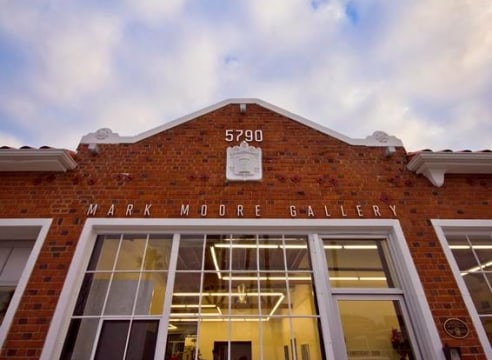
Hawaii, Intergral, 2015 / ink on paper / 33 x 23 inches
Collection of the Honolulu Museum of Art
Kim Rugg / Blooming, 2015 / quilted fabric with silkscreened newspaper text / 17 x 17 inches
America, 2013 / ink on paper / 28 x 42 inches
Collection of the Museum of Fine Arts, Houston (TX)
The Story Is One Sign, 2010 / reconfigured newspaper / 30 panels
Collection of the Norton Museum of Art (FL)
No More Dry Runs, 2008 / newsprint (Financial Times) / 23.62 x 14.75 inches
Collection of the National Gallery of Art (D.C.)
Scratch the Dog, 2006 / newsprint (Los Angeles Time) / 22.83 x 12.6 inches
collection of the Museum of Contemporary Art, San Diego (CA)
Mirrored Stars, 2006 / postage stamp, envelope / 8 x 12 inches
Collection of the Aldrich Contemporary Art Museum
Bullets Ain't Stoppin' Him, 2007
reconfigured comic book (Superman) / 13.39 x 20.87 inches
Collection of the Frederick R. Weisman Art Foundation (CA)
Over the Edge, 2009 / reconstructed newspaper
Collection of Los Angeles County Museum of Art (CA)
California, 2014 / ink on paper / 15.66 x 13.38 inches
A Single White Lilly, 2013 / reconstructed newspaper / 31.5 x 14.57 inches
The World, 2012 / Reconfigured paper map of the world / 36.2 x 55.9
Installation View: "Girl Talk" / Contemporary Art Museum, Raleigh / 2012
Return to the Skies, 2010 / ink and pencil on paper / 23 x 26 inches
Cap'n Crunch, 2009 / cereal packaging on board / 13.78 x 5.91 inches
There Are Still Unresolved Questions, 2009 / ink, pencil, acrylic on paper / 23 x 13 inches
An Amazing Feat, 2008 / newsprint (Los Angeles Times) / 22.83 x 12.6 inches
Pimple, 2008 / reconfigured wallpaper on MDF / site specific / dimensions variable
Playing on Eccentricity, 2008 / newsprint (New York Times) / 22.83 x 12.6 inches
Bam, 2008 / reconfigured comic book / 14 x 23 inches
Hawaii Dry, 2015 / ink on paper / 23 x 33 inches
Rugg is renowned for her meticulous and labor-intensive work which involves deconstructing and slicing an object into minute shards to then re-organize and reconstruct it according to arbitrary codes. The original meaning is removed to reveal new ones, and to corrupt or destroy the object’s function. This act of mischievous “sabotage” is applied to ephemeral and iconic objects such as newspapers, comic books, product boxes, sweaters, and stamps, and more recently to larger formats such as wallpaper and furniture – and, by doing so, she turns a neutral vehicle for a message into an object to be considered.
By giving value to something which would normally be disposed of, Rugg transgresses conventional systems by obliterating what is conceived to be the important element, “the content”, and retaining everything else, the material, the shapes, the typography, the color palettes, and the layout. Through these works, she continues her investigation into the relationship between images and their signifier. She questions the way in which the information we process daily is preconceived and prompts the viewer to consider the familiar from an entirely new perspective.
“Some people like taking their time," says Kim Rugg, whose artistic achievements are measured in millimeters, spent X-ACTO blades and picas. We spent the afternoon with Rugg in her London home and studio talking about her work re-imagining newspapers, comics, stamps, and cereal boxes using their existing form while rearranging their content. Kim finds inspiration from the mundane and common objects around us. Her wicked knife skills and tenacious attention to detail have create a body of work that is as impressive as it is curious.
Matter is neither created nor destroyed in Kim Rugg's work, but surgically, strategically repurposed. Rugg reconfigures familiar printed materials: here newspapers, magazines, and maps; previously also postage stamps, comic books and cereal boxes. By altering their forms and tweaking or altogether eliminating their legibility, she slams on the visual brakes, forcing a closer, slower inspection of objects we typically look through rather than at. The raw materials of her enterprise give up their transparency and functionality as information delivery systems to become instead sculptural interpretations of those same systems. They sacrifice one type of authority but assume another.
Rugg received her MFA in Sculpture from the Royal College of Art (London). Her work can be seen in the permanent collections of the National Gallery of Art (D.C.) and the Frederick R. Weisman Foundation (CA), the Museum of Contemporary Art, San Diego (CA), Honolulu Museum of Art, the Norton Museum (FL), and the Museum of Fine Arts Houston (TX) among others. She has been included in exhibitions at the San Jose Institute of Contemporary Art (CA), Elizabeth Foundation for the Arts (NY), Galerie Schmidt Maczollek (Cologne), and Nettie Horn Gallery (Manchester), P.P.O.W. Gallery (NYC), and was the recipient of the Thames and Hudson Prize from the Royal College of Art Society in 2004. She lives and works in London (UK).
